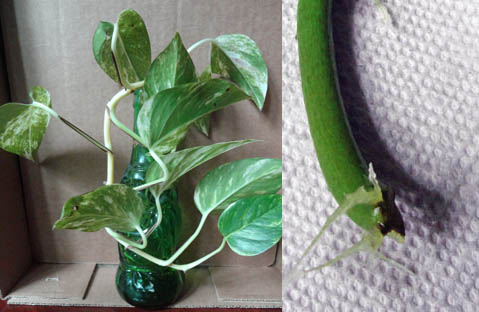Propagating Plants from Cuttings
By Elaine Homstad, Fairfax Master Gardener

Hydrangea from cuttings
Well, with a few simple (and often recycled) materials, you can easily make new plants to keep or give away.
Many people think that propagating plants is a task best left for professional growers or more experienced gardeners, but that is just not true. There are many, many plants, particularly houseplants and herbs, that are very easily propagated. And there are many different methods, some quite simple and some a bit more involved, that can be employed.
Propagation from cuttings is called asexual propagation. In this type of propagation, a part of a grown “parent” plant is taken from its stems, leaves or roots. This part is placed into a medium for growth and can develop into a new plant. The advantages to this type of reproduction are that the new plant is genetically identical to its parent, and it is often easier and faster than growing from seed. It may also be the only way to reproduce some hybridized cultivars.
According to the Virginia Cooperative Extension publication 426-002, “The major methods of asexual propagation are cuttings, layering, division and budding/grafting. Cuttings involve rooting a severed piece of the parent plant; layering involves rooting a part of the parent and then severing it; and budding and grafting are joining two plant parts from different varieties.”
For the home gardener, the simplest type of propagation is rooting a cutting in either sterile rooting medium or water. I have had great success rooting houseplants and herbs in water, although it is important to note that you should change the water frequently to keep it from becoming stagnant, and you should be aware that some plants rooted in water do not perform as well once transplanted into soil.
Plants that have done very well for me using the water method include angel-wing begonia, spider plant, ivy, coleus, Christmas cactus, pothos, philodendron, oregano, mint and basil.

African Violet propagation from leaf
The African Violet Society of America recommends starting the leaves in water, taking care to keep only the leaf’s stem in the water, and the leaf itself suspended above.

Philodendron beginning rooting from cutting
Some important things to remember when making and rooting cuttings:
- Use a clean knife, scissors or pruners. Clean the blade with rubbing alcohol before making each cut.
- Take a long enough piece of a stem cutting (4 to 6 inches) so that it includes at least 2 “nodes” — the section of the stem where the leaf attaches to it.
- Remove the leaves that will be below the rooting medium or water. Gently pinch them off or cut them close to the stem. Do not tear them off. You do not want any of the stem or branch to come with them.
- If using rooting hormone powder, be sure to tap off the excess before inserting into the rooting medium.
- If using rooting medium, be sure to keep the cutting moist by misting with water and tenting loosely with a plastic bag, but take care not to overwater, to prevent the cutting from rotting.
- If you are trying to root a large-leafed plant (such as a hydrangea), reduce the leaf surface of the remaining leaves by about two-thirds.
- If you are rooting cuttings in water, use a green or amber colored bottle, or cover a clear glass container with something to block the light. Keep it out of direct sunlight, and change the water frequently to avoid algae formation and stagnation.
Resources
Propagation by Cuttings, Layering and Division, Virginia Cooperative Extension Publication 426-002
Propagating Foliage & Flowering Plants, Texas A&M Agrilife Extension
Starting Violets from Leaves, Kent and Joyce Stork, African Violet Society of America
… updated 2021